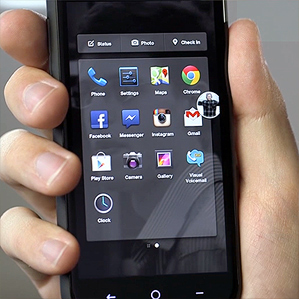Facebook Reacts to Criticisms of “Home” App; Promises Upgrades
Facebook Home—an app for Android smartphones that provides users with a constant stream of images, messages, and updates from friends on the social network—launched with fanfare a month ago along with the promise that additional features would be added shortly (see “The Facebook Phone Is Finally Here, but Who Wants It?”). Now, as some users level poor reviews at the app, the team behind it is focused on making those upgrades happen—and fast.

During a small, informal gathering of journalists at the company’s Menlo Park, California, headquarters, director of mobile engineering Cory Ondrejka and director of product Adam Mosseri gave a sneak peek of some Home features that they said will be added in the next couple of months.
Home, which refashions the smartphone experience around your friends’ Facebook activity, is currently available as an Android app that can be downloaded onto just a handful of smartphones, and it comes preloaded on the HTC First smartphone. It represents Facebook’s biggest push yet into the mobile market, which it sees as vital to its future, so the success of Home is crucial to the social network.
Despite some bad reviews, it appears that people are, in fact, using it. In the first month, about one million people downloaded Home, Ondrejka said, which lines up with what the Home team expected (he would not, however, say how many of those people are still actively using Home).
The app also seems to be having the desired effect on user activity. Ondrejka said that Home users are spending 25 percent more time on Facebook, and are interacting with other users 25 percent more as well. He added that there has also been a 7 percent increase in chat usage and a 10 percent increase in the amount of messages that Home users send, on average. And over 10,000 people were so desperate to get Home on their unsupported Android smartphones that they installed a hacked version, Mosseri said.
Despite all these installations, Facebook Home has only a two-star rating in the Google Play online store. And the price of the HTC First, initially available just through AT&T in the U.S., was recently slashed from $99 (with a two-year contract) to 99 cents—not usually a good sign so soon after a product’s launch.
Ondrejka admits that some things were clearly missing at launch. He said users have complained about those things, and Facebook is now working on them. These include a launcher that makes it easier to see your non-Facebook apps and doesn’t reorganize them, and a way to create folders of apps within the launcher. Also lacking was a dock at the bottom of the screen that gives you quick access to your most important apps (such as the phone dialer, maps, and e-mail).
“We want you to be able to use Home and not feel like the apps you’ve spent time curating have been moved around,” Ondrejka said.
Mosseri said that while users like Chat Heads—little bubble-shaped pictures of friends that can follow them around from app to app—they found it annoying to initiate a chat session. So the team is working to make it easier to start conversations; he showed off a feature that will let users more easily access a buddy list through Home.
As for when Home will be available for more smartphones, it’s not quite clear. Mosseri says technical limitations—such as dealing with the different resolutions and amounts of memory on different phones—complicate things. It is slated to arrive on tablet computers eventually, though. Ondrejka said the team has already tested it on some tablets and found that Home’s gestural interface and photo-centric interface work well.
Keep Reading
Most Popular
Large language models can do jaw-dropping things. But nobody knows exactly why.
And that's a problem. Figuring it out is one of the biggest scientific puzzles of our time and a crucial step towards controlling more powerful future models.
How scientists traced a mysterious covid case back to six toilets
When wastewater surveillance turns into a hunt for a single infected individual, the ethics get tricky.
The problem with plug-in hybrids? Their drivers.
Plug-in hybrids are often sold as a transition to EVs, but new data from Europe shows we’re still underestimating the emissions they produce.
Google DeepMind’s new generative model makes Super Mario–like games from scratch
Genie learns how to control games by watching hours and hours of video. It could help train next-gen robots too.
Stay connected
Get the latest updates from
MIT Technology Review
Discover special offers, top stories, upcoming events, and more.